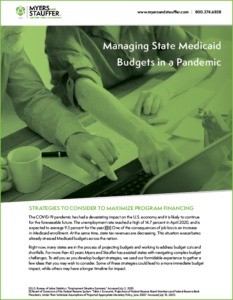The COVID-19 pandemic has had a devastating impact on the U.S. economy and it is likely to continue for the foreseeable future. The unemployment rate reached a high of 14.7% in April 2020, and is expected to average 9.3% for the year.[i][ii] One of the consequences of job loss is an increase in Medicaid enrollment. At the same time, state tax revenues are decreasing. This situation exacerbates already stressed Medicaid budgets across the nation.
Right now, many states are in the process of projecting budgets and working to address budget cuts and shortfalls. For more than 43 years Myers and Stauffer has assisted states with navigating complex budget challenges. To aid you as you develop budget strategies, we used our formidable experience to gather a few ideas that you may wish to consider. Some of these strategies could lead to a more immediate budget impact, while others may have a longer timeline for impact.
This list is not exhaustive, and we would be glad to schedule time to discuss these and other ideas as you strategize to address the Medicaid fiscal impact due to COVID-19.
[i] U.S. Bureau of Labor Statistics. “Employment Situation Summary.” Accessed July 2, 2020.
[ii] Board of Governors of the Federal Reserve System. “Table 1. Economic Projections of Federal Reserve Board Members and Federal Reserve Bank Presidents, Under Their Individual Assumptions of Projected Appropriate Monetary Policy, June 2020.” Accessed July 10, 2020.
Strategies and Considerations
Rate-Setting and Financing
Upper Payment Limit (UPL)
- Introduce or maximize the state’s draw down of federal funds through UPL demonstrations.
- Review existing demonstrations for enhancements to Medicare UPL.
- Evaluate whether new UPL opportunities exist for services tied to the average commercial rate (ACR).
- Consider the above for:
- Physician.
- ICFs/ID.
- In/outpatient hospital.
- Nursing facilities.
- Clinics.
- Other practitioner services tied to the ACR.
Provider Fees/Taxes
- Introduce or maximize provider fees/taxes.
- Review existing fees/taxes for available room under the federally-required safe harbor threshold.
- Evaluate new fee/tax opportunities on permissible provider/service classes not currently assessed.
- Consider the above for:
- Hospital.
- Nursing facilities.
- Ground emergency medical transportation.
- Pharmacy.
- MCO.
- Dental.
- Ambulatory surgical centers.
- Radiology.
- Others.
Rate Adjustments
States may have to consider:
- Temporary rate freeze to pause scheduled rate increases or inflationary adjustments.
- Temporary rate reductions.
- Comparison of rates to Medicare or market to identify opportunities for reductions.
Benefit/Program Integrity
Member Data Accuracy
- Identify duplicate members and secure match with vital statistics’ date of death records to ensure accuracy of PMPM payments.
- Utilize interstate eligibility match through Public Assistance Reporting Information System (PARIS) to identify individuals enrolled in Medicaid in multiple states.
Program Integrity
- Revisit provider compliance. 1135 waivers and other state actions relaxed certain program integrity activities during the pandemic.
Benefit Design and Utilization Management
- Ensure benefit design is consistent with best practices and properly reflected in MMIS and PBM adjudication logic.
- Enhance system edits and audit to drive proper utilization and billing.
- Review accuracy of MMIS and PBM edits to accurately reflect policy and benefit design in claims adjudication systems.
- Institute additional utilization management initiatives.
- Review optional versus mandatory services offered.
Managed Care
Encounter Data
- Ensure the accuracy and completeness of encounter data to assist managed care actuary’s rate setting process.
Managed Care Expansion
- Expand managed care programs to incorporate other populations and/or services to achieve savings and budget predictability.
Medical Loss Ratio (MLR)
- Identify penalties due to states if the MLR threshold is exceeded.
- Ensure actuaries have access to properly audited MLRs going into rate setting to avoid inflated PMPMs.
- Consider raising the minimum MLR rebate threshold and enforcing performance guarantees.
Other
- Additional waiver opportunities.
- Exploring and maximizing grant opportunities.
- Supplemental cost reporting related to provider COVID-19 expenditures to assist with reimbursement decision making.



 Tara Clark, CPA
Tara Clark, CPA


